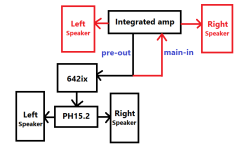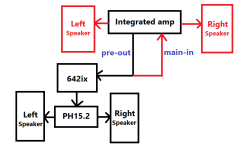I have an integrated amplifier that has a set of pre-out and main-in channels. I also have two power amplifiers.
Can I connect two power amplifiers to the pre-out channels of the integrated amplifier? I mean to use the integrated amplifier as a preamplifier and use Y-shape RCA interconnects to link the preamplifier to the two power amplifiers.
My concern is about the output impedance seen by the integrated amplifier (now used as a preamplifier), since it might decrease the total impedance presented to the preamplifier due to the parallel connection of the two power amplifiers.
Edit: Add an illustration.
Black line is floor-standing system and red line is bookshelf system.
Can I connect two power amplifiers to the pre-out channels of the integrated amplifier? I mean to use the integrated amplifier as a preamplifier and use Y-shape RCA interconnects to link the preamplifier to the two power amplifiers.
My concern is about the output impedance seen by the integrated amplifier (now used as a preamplifier), since it might decrease the total impedance presented to the preamplifier due to the parallel connection of the two power amplifiers.
Edit: Add an illustration.
Black line is floor-standing system and red line is bookshelf system.
Attachments
Last edited:
I mean to use the integrated amplifier as a preamplifier and use Y-shape RCA interconnects to link the preamplifier to the two power amplifiers.
Yes.
I usually discount commercail integrated amps with the pre- and power-amps “separate”. This makes the device way more versatile.
BTW, what amp?
Paralleling the inputs of the 2 amplifiers will means net input impedance is less and you need to ensure the Rout of the pre-amp section is low enuff to drive the lower impedance.
dave
Yes, it does.Does the integrated amp have little metal jumpers that go from pre out to amp in?
The preamplifier (integrated amp) is a Braun/ADS Atelier A2. The first power amplifier is the A2 itself. I employ it to drive the bookshelf speakers. The second power amplifier is a set of ADS 642ix electronic crossovers and an ADS PH15.2 power plate amplifier. I use them to drive the floor-standing speakers.
The output imp. of the A2 is 1V / 220 Ohms.
The input imp. of the 642ix is 11 kOhms.
The input imp. of the PH15.2 is 50 kOhms.
The output imp. of the A2 is 1V / 220 Ohms.
The input imp. of the 642ix is 11 kOhms.
The input imp. of the PH15.2 is 50 kOhms.
No, I used only one power amplifier each time and turned off the unused power amplifier.Do you always turn on both power amplifiers when you want to listen?
Do you recommend to turn on both amplifiers when listen?Some line inputs behave very non-linearly when the equipment is off.
Not necessarily, you can also try to find a schematic of the amplifier and the active crossover to see if there is any problem at all, or think of some scheme where the connection to the switched-off amplifier is opened.
Last edited:
My amp is Braun/ADS Atelier A2.
https://www.worthpoint.com/worthopedia/ads-braun-a2-integrated-amplifier-72989913
dave
Attachments
The preamplifier (integrated amp) is a Braun/ADS Atelier A2. The first power amplifier is the A2 itself. I employ it to drive the bookshelf speakers. The second power amplifier is a set of ADS 642ix electronic crossovers and an ADS PH15.2 power plate amplifier. I use them to drive the floor-standing speakers.
The output imp. of the A2 is 1V / 220 Ohms.
The input imp. of the 642ix is 11 kOhms.
The input imp. of the PH15.2 is 50 kOhms.
If I understand it correctly, the A2 has only one power switch, so the first power amplifier is always on when the preamplifier is on.
Regarding the second one, does the A2's preamplifier drive the ADS 642ix which then drives the ADS PH15.2, or does the A2's preamplifier drive the parallel connection of the inputs of the ADS 642ix and ADS PH15.2?
Yes, but when I'd like to listen to the floor-standing pair (powered by 642ix and PH15.2), I simply released the speaker selector set-A button on the A2. So no speakers are being powered by the A2.If I understand it correctly, the A2 has only one power switch, so the first power amplifier is always on when the preamplifier is on.
The A2's preamplifier drives the ADS 642ix which then drives the ADS PH15.2.Regarding the second one, does the A2's preamplifier drive the ADS 642ix which then drives the ADS PH15.2, or does the A2's preamplifier drive the parallel connection of the inputs of the ADS 642ix and ADS PH15.2?
OK, then the potential issue is distorted sound from the bookshelf speakers if the input of the ADS 642ix behaves very non-linearly when it is off. If that's the case, turning on the ADS 642ix (the ADS PH15.2 can remain off) or interrupting the signal connection to the ADS 642ix should solve it.
You said there might be an issue—the distortion—with the bookshelf speakers, which were driven by the power-amplifier section of the integrated A2, if the 642ix was turned off. Why?OK, then the potential issue is distorted sound from the bookshelf speakers if the input of the ADS 642ix behaves very non-linearly when it is off. If that's the case, turning on the ADS 642ix (the ADS PH15.2 can remain off) or interrupting the signal connection to the ADS 642ix should solve it.
And, how about the floor-standing speakers? Why do they have no potential issue?
Additional info:
The output imp. of the A2 is 1V / 220 Ohms.
The input imp. of the A2 is 1V / 220 kOhms.
The input imp. of the 642ix is 11 kOhms.
The input imp. of the PH15.2 is 50 kOhms.
The output imp. of the A2 is 1V / 220 Ohms.
The input imp. of the A2 is 1V / 220 kOhms.
The input imp. of the 642ix is 11 kOhms.
The input imp. of the PH15.2 is 50 kOhms.
You said there might be an issue—the distortion—with the bookshelf speakers, which were driven by the power-amplifier section of the integrated A2, if the 642ix was turned off. Why?
And, how about the floor-standing speakers? Why do they have no potential issue?
An equipment designer normally ensures that a line input behaves as an almost perfectly linear and fairly high impedance as long as the equipment is powered up, but not necessarily when it is off. For example, I know from experience that the record input of a Philips CDR 775 recorder draws a grossly distorted input current when the CDR 775 is off and there is signal applied to its line input.
When your preamplifier has to drive switched-off equipment in parallel with switched-on equipment, the distorted current (if any) drawn by the line input of the switched-off equipment will distort its output voltage, which you can then hear through the switched-on equipment.
The floor standing speakers have no problem, because the power amplifier of the A2 is always on when the preamplifier is on. The loudspeakers are disconnected from it, but it is powered up (at least that is how I understand it, and what is usually done in such amplifiers).
The bookshelf speakers may have a problem if the active crossover is off when they are used. The active crossover may then draw a distorted current from the preamplifier, although it depends on the design of the active crossover whether it actually does draw distorted current.
- Home
- Source & Line
- Analog Line Level
- One pre-out to two power amps

